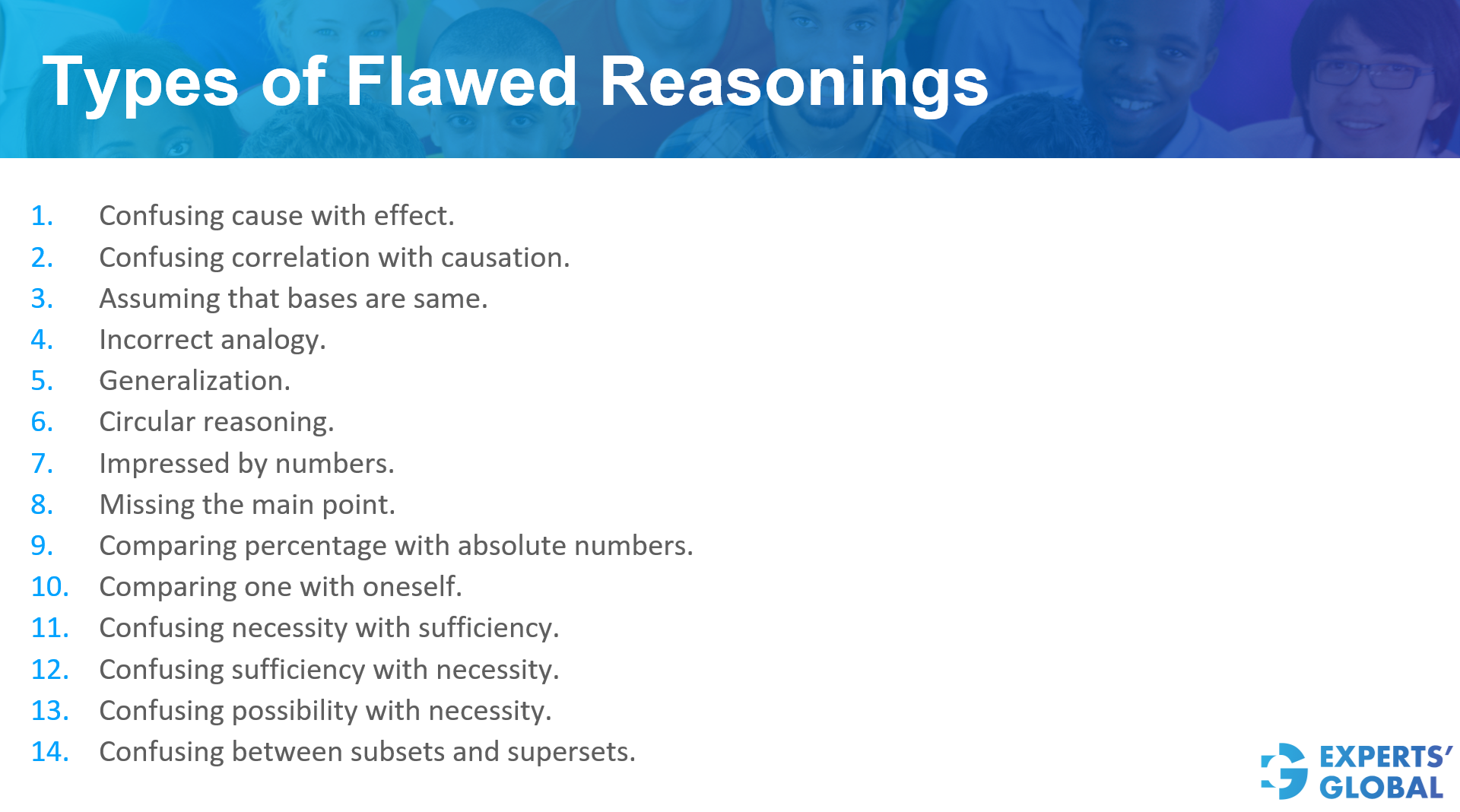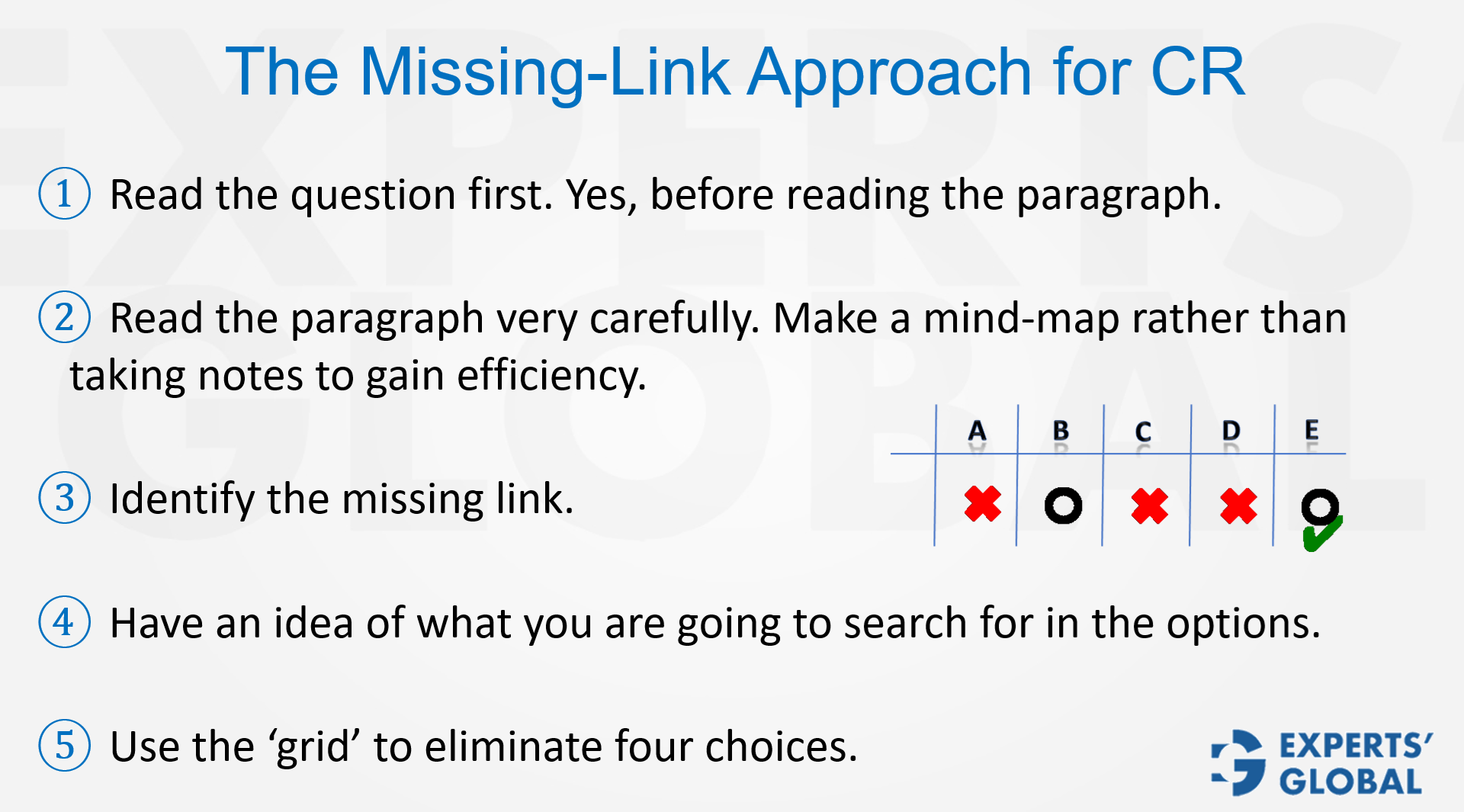Invest 30 seconds...
...for what may lead to a life altering association!
Help Line
- +91.8800.2828.00 (IND)
- 1030-1830 Hrs IST, Mon-Sat
- support@expertsglobal.com
...for what may lead to a life altering association!


Finding the flaw questions test whether you can spot broken logic. Read the stem, develop mind-map, then spot the discrepancy. Recognize common patterns – faulty analogy, false dilemma, assumptions, correlation-for-causation, circularity, overlooked alternatives etc. Go by elimination and select the option that describes the weakness.
Flaw questions focus on diagnosing why a conclusion does not logically follow from its premises. This overview introduces a structured lens: read the stem first, map premise and conclusion, then test for patterns such as faulty analogy, false dilemma, unwarranted assumptions, correlation-for-causation, circularity, and overlooked alternatives. The video previews rapid checks; the article expands with examples and cues. These habits strengthen analytic reading in GMAT prep and transfer to evidence-based argument evaluation valued throughout MBA admissions and professional decision-making contexts.

Critical reasoning questions that deal with finding the flaw are both subtle and insightful. They test not just your comprehension but also your ability to see when an argument has logical weaknesses. These questions generally fall into two related types.
In this case, the question directly asks you to identify what is wrong with the reasoning. For example, a passage may be followed by a question stem like, “A serious flaw in the reasoning is that…”. Alternatively, in dialogue-based questions, you may see: “Second person’s response to the first person is flawed in that…”. In both cases, the task is to look closely at the logical structure and highlight where it breaks down.
This type looks like a general CR question – assumptions, strengthening, weakening, explanation, evaluation etc – but solving it requires identifying the flaw hidden at the heart of the reasoning. The question may not use the word “flaw,” but if you cannot spot the error in the logic, you are likely to miss the correct answer.
The GMAT tests you on fourteen common categories of flawed reasoning. You are not required to memorize these terms. Instead, what matters is developing the sensitivity to recognize flawed logic as soon as you encounter it.

The essence of these questions lies in understanding how arguments can go wrong. Often, an argument may sound persuasive at first glance, but the flaw becomes visible when you slow down and connect the premise to the conclusion carefully. Identifying what does not follow, what has been overlooked, or what has been assumed incorrectly is the skill being tested.
Step 1: Begin with the question stem to ensure you understand the exact task.
Step 2: Study the reasoning carefully; create a mind-map and pinpoint the missing-link.
Step 3: Define your broad expectation from the correct answer choice.
Step 4: Eliminate four options; the one that remains is your answer.
Before confirming, verify.

Recognizing flawed reasoning is not just a GMAT skill. It is also central to the kind of critical thinking business schools value. When you can see through errors in reasoning, you can assess decisions, policies, and arguments in a more structured way. To develop this, practice with high-quality questions and take time to reflect on both correct and incorrect answers. Alongside, use a GMAT preparation course that guides you through flaw recognition step by step, building the sharp analytical mindset required for success.
Flaw-based Critical Reasoning questions highlight the importance of spotting weaknesses in logic rather than accepting arguments at face value. They may appear directly, asking you to identify a flaw, or indirectly within assumption, strengthening, weakening, or evaluation formats. Common flaws include faulty analogies, false dilemmas, and correlation mistaken for causation. Building familiarity with these recurring patterns ensures sharper reasoning and higher accuracy. Practicing with structured GMAT simulations refines this skill, helping you approach such questions with confidence, precision, and clarity.
Flaw-based reasoning reminds us that strength lies not only in building arguments but also in recognizing where they fall apart. In GMAT preparation, this habit sharpens analytical clarity; in MBA applications, it nurtures essays and interviews grounded in sound reasoning; in life, it cultivates discernment amid persuasive claims. Each time you test yourself with a GMAT mock, you practice separating substance from illusion, learning to question assumptions and uncover hidden gaps. This discipline fosters resilience, humility, and the wisdom to pursue truth over appearance, qualities that extend far beyond examinations.